
From figurative painting to surreal symbolism
|
|
|
|
|
|
|
|
|
|
|
|
|
|
|
|
|
|
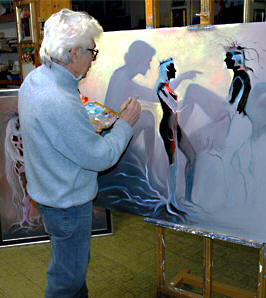
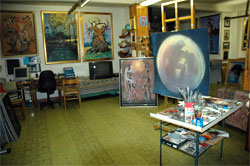 |
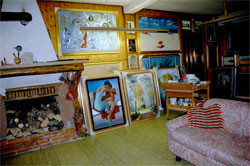 |
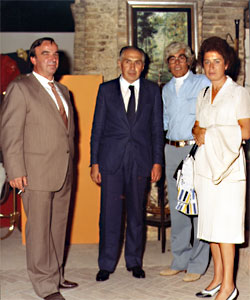 |
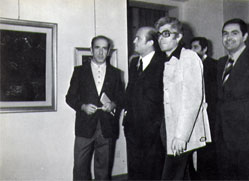 |
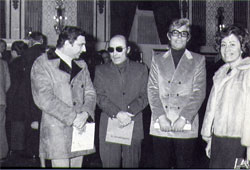 |
Guglielmo Coladonato was born in Torricella Peligna, in the province of Chieti, on 3rd January 1933. He lives and works at Aranova near Rome.
The atmosphere of his land of origin, the “rough yet gentle” Abruzzo,
has accompanied the artistic development of this “intense painter, who
uses lively colours and features an interesting choice of subjects”, as
he’s described in the Enciclopedia dell’Arte Italiana per il Mondo. We
may add here that Coladonato prefers faesite (synthetic wood) for his
oil paintings, often using the rough side, which makes retouching
impossible, because he considers this material better than canvas due to
its capacity to preserve colours and the whole artwork.
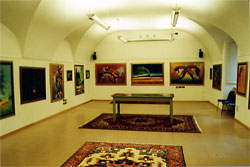 |
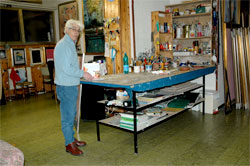 |
Critics define Coladonato’s work as spacing from figurative to surreal
symbolism, with brushstrokes that are at times smooth, to express female
grace, at others imaginative, as if they were sculpted in the colour and
light of the figures, landscapes and still lives, to reawaken a certain
interior affliction and the contradictions of life itself.
His childhood was strongly marked by suffering: after the death of his
mother, his harsh and relentless father sent him out to work as a
shepherd boy, spending long periods of solitude in the wilderness of
Mount Irco, where he began to make his first stone sculptures. His
adolescence was further troubled by the dramatic events of World War Two,
during which he was struck by shrapnel and lost an eye, and was later
welcomed in the Villaggio del Fanciullo, a refuge for children at Silvi
Marina, where he began his sculpting education.
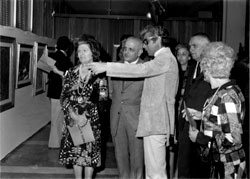 He
turned to painting after meeting the brothers Tommaso, Giuseppe and
Michele Cascella, in Chieti, who encouraged him to attend the local art
school. After completing his studies, he went to work first in Piemonte,
at the Law Courts of Saluzzo and then, in 1961, at the Court of Appeals
of Rome, where he was employed until 1970, at which time he had fully
convinced himself that his true vocation was painting, having
participated, since 1967, in a number of group exhibitions in various
Italian cities.
He
turned to painting after meeting the brothers Tommaso, Giuseppe and
Michele Cascella, in Chieti, who encouraged him to attend the local art
school. After completing his studies, he went to work first in Piemonte,
at the Law Courts of Saluzzo and then, in 1961, at the Court of Appeals
of Rome, where he was employed until 1970, at which time he had fully
convinced himself that his true vocation was painting, having
participated, since 1967, in a number of group exhibitions in various
Italian cities.
 From then until today,
Coladonato has held about a hundred individual exhibitions, some of
which at prestigious venues: the Museo di Roma, the Museum of Science
and Technology of Milan, the United Nations Building in New York, and
various art galleries in Paris, London, Caracas, Belgium, Canada,
Australia, receiving many prizes and awards. His works are exhibited in
museums and private collections in a number of countries.
From then until today,
Coladonato has held about a hundred individual exhibitions, some of
which at prestigious venues: the Museo di Roma, the Museum of Science
and Technology of Milan, the United Nations Building in New York, and
various art galleries in Paris, London, Caracas, Belgium, Canada,
Australia, receiving many prizes and awards. His works are exhibited in
museums and private collections in a number of countries.
Among the enthusiasts of Coladonato’s talent was the great Spanish
artist Salvador Dalì, whom he had met during a trip to Spain in 1967,
and who predicted a bright future for him as an artist, and the famous
Abruzzo author Ignazio Silone, who, in 1977, a year before his death,
expressed the desire to meet the painter and visited him in his studio
on the Via Aurelia at Torrimpietra, defining him as "a painter of
reality, brimming with fire, always in search of moments of pathos and
humanity".